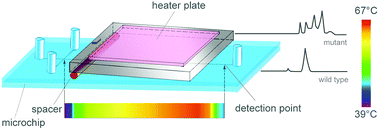DNA mutation detection with chip-based temperature gradient capillary electrophoresis using a slantwise radiative heating system†
Abstract
A simple and robust chip-based temperature gradient

* Corresponding authors
a
Department of Cell Biology, Key Lab of Cell Biology of Ministry of Public Health, China Medical University, Shenyang, China
E-mail:
jfang61@netease.com
Fax: +86-24-23256087
Tel: +86-24-23256666-5347
b
Research Center for Analytical Sciences, Northeastern University, Box 332, Shenyang, China
E-mail:
fangzl@mail.edu.cn
c Information & Control Engineering Faculty, Shenyang Jianzhu University, Shenyang, China
A simple and robust chip-based temperature gradient

 Please wait while we load your content...
Something went wrong. Try again?
Please wait while we load your content...
Something went wrong. Try again?
H. Zhang, J. Zhou, Z. Xu, J. Song, J. Dai, J. Fang and Z. Fang, Lab Chip, 2007, 7, 1162 DOI: 10.1039/B701649B
To request permission to reproduce material from this article, please go to the Copyright Clearance Center request page.
If you are an author contributing to an RSC publication, you do not need to request permission provided correct acknowledgement is given.
If you are the author of this article, you do not need to request permission to reproduce figures and diagrams provided correct acknowledgement is given. If you want to reproduce the whole article in a third-party publication (excluding your thesis/dissertation for which permission is not required) please go to the Copyright Clearance Center request page.
Read more about how to correctly acknowledge RSC content.
 Fetching data from CrossRef.
Fetching data from CrossRef.
This may take some time to load.
Loading related content
